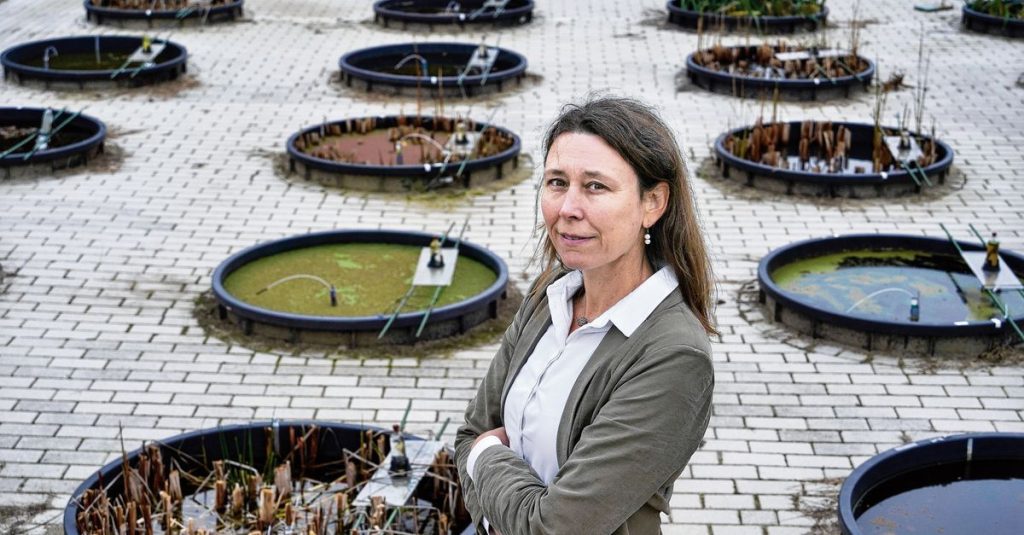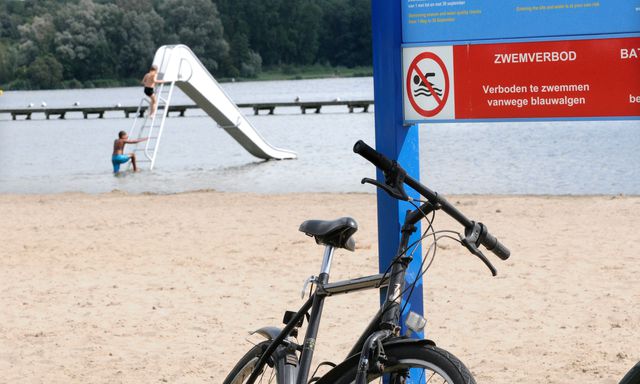Forty black plastic containers were dug into the ground, their edges protruding above the soil. The ponds are filled with greenish water. “But plants and fish disappeared a while ago,” says ecologist Sarian Kosten, in a remote corner of Radboud University Nijmegen. She and her colleagues are experimenting with the greenhouse gas methane emissions from trenches, and how you can reduce those emissions. They have published many articles on this topic in recent months.
Moats have long been overlooked as a source of methane. Four years ago, Kosten got up on her hips in a ditch in Elst, near Nijmegen, to tell this newspaper about it. And the Netherlands has quite a few locks: their length is 330,000 km. If trenches are included in the Netherlands’ methane emissions, they could be 15 percent higher than what is currently reported to the United Nations Framework Convention on Climate Change, the United Nations organization that monitors compliance with a climate treaty set up in 1992.
Read this NRC article from 2018: Forgotten greenhouse gases in Dutch trenches
Trenches naturally emit methane, but these emissions tend to increase when they are adjacent to farmland. The hole where Kostin stood three years ago was adjacent to a meadow. An important reason is the excessive use of fertilizers. Crops don’t absorb everything. A large part, along with organic matter (such as plant residues), washes into adjacent trenches. There it stimulates the growth of plants as well as algae. As it dies and sinks to the bottom, it is broken down by bacteria. This requires a lot of oxygen. Once it is used, the decomposition process changes. Then other bacteria, the ones that produce methane, become active. The gas can then exit the trench in two ways. It dissolves in water and spread out up. Or gas bubbles—which happen when too much methane forms at the bottom—form. The whole process is catalysed by climate change.
shoveling is better
After this discovery, Kosten began to focus more on how to reduce methane emissions. “What happens a lot is that ditches are dug,” she says. A layer of organic material (dead animals and plants) is excavated from the bottom of the trench, because it is the material that the methane bacteria live on. “One of the questions we had was what happens to that dredged material after that,” Kosten says. They often pile up somewhere to dry. Nijmegen ecologists carried out measurements at a dredging depot in Heteren. “When dredging starts to dry up, we also see an increase in methane release there,” Kosten says. However, on the whole, it’s not quite as likely to have been launched from the ditch, she says. “So shoveling seems to be an improvement.”
Another option is to sprinkle some type of slurry into the trench that binds the phosphates. Phosphates, a phosphorous compound, is one of the fertilizers (along with nitrates) that trickle down from the fields. Kosten and his colleagues experimented with something called a modified lanthanum clay (trade name: Alphosloc). This clay contains the chemical element lanthanum, which binds phosphates. “In addition to nitrogen, algae also need phosphorus to grow,” Kostin explains. Lanthanum clay limits the availability of phosphates, and therefore phosphorus. In tests carried out in black barges, which were filled with water and dredged sediment from the Wylerbergmeer in Nijmegen, they noted lower methane emissions, according to Article published this month.
Photo by Philip Franson
Backwater
And the mud has an effect not only on algae, ecologists have discovered, but also on all kinds of floating plants. “Their roots often don’t reach the bottom, so they have to get phosphate from the water column,” Kostin says. But if the phosphates there are bound to the lanthanum mud, those floating plants will have a hard time. This has been shown to be beneficial for methane emissions. “Floating plants limit the incidence of light in the trench, and thus the growth of submerged water plants.” And trenches with many submerged vegetation seem to release much fewer methane bubbles. We think they add oxygen to the soil through their roots. Spikeweed, for example, is known to leach a lot of oxygen.” The idea is that in soils, as organic matter decomposes, the transition to anoxic decomposition and methane occurs much less frequently. Ratio of floating plants versus submerged plants It also affects methane emissions.
However, Kosten believes that at the moment it does not make sense to spread lanthanum mud in Dutch trenches. “It only works if you don’t have a steady supply of phosphate, which is the case in most trenches.” Costin says it can work in isolated waters. “Sometimes the clay is used in the bathing water.”
Read about swimming water: The mud layer should dissolve blue-green algae at Kralingse Plas in Rotterdam
In another study, ecologists looked at the effects of animals bobbing at the bottom of a pit. In black tanks they conducted experiments on carp. Its presence appears to reduce methane emissions, Kostin says. The hypothesis is that oxygen-rich water enters the soil as a result of the upwelling. This looks positive. But in black boxes with carp, carbon dioxide is emitted2 Right. In general, greenhouse gas emissions have increased.
worms and carp
Next, experiments were conducted in aquariums with tubifex worms, which live at the bottom of lakes and rivers. “It turns out to be the best subsoil for carp,” Kosten says. But here, too, environmentalists saw a complication. In systems with fish, the worms were eaten, and fish ultimately had a negative effect on methane emissions. “So the impact of fish is very dependent on other organisms still present in the sediment.”
Last year, Kosten received a Vidi grant from NWO (€800,000) for further research into the impact of subsoils. Among other things, you want to study the effects of crayfish. “On the one hand, they stir up the soil, and on the other hand they cut back the plants so they can bring less oxygen into the soil through their roots,” Kostin says. It is not yet clear how this will work, in combination with other organisms.
In any case, options are emerging to reduce methane emissions from the trenches, Costin says. “But most interventions are of little benefit if the supply of fertilizer from the fields is not sharply reduced.”
A version of this article also appeared in the December 3, 2022 newspaper

“Total coffee specialist. Hardcore reader. Incurable music scholar. Web guru. Freelance troublemaker. Problem solver. Travel trailblazer.”









More Stories
GALA lacks a chapter on e-health
Weird beer can taste really good.
Planets contain much more water than previously thought